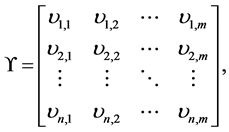Advances in Linear Algebra & Matrix Theory
Vol.05 No.04(2015), Article ID:61736,11 pages
10.4236/alamt.2015.54016
A Generalization of Cramer’s Rule
Hugo Leiva
Department of Mathematics, Louisiana State University, Baton Rouge, LA, USA

Copyright © 2015 by author and Scientific Research Publishing Inc.
This work is licensed under the Creative Commons Attribution International License (CC BY).
http://creativecommons.org/licenses/by/4.0/



Received 27 April 2014; accepted 4 December 2015; published 7 December 2015
ABSTRACT
In this paper, we find two formulas for the solutions of the following linear equation
 , where
, where  is a
is a  real matrix. This system has been well studied since the 1970s. It is known and simple proven that there is a solution for all
real matrix. This system has been well studied since the 1970s. It is known and simple proven that there is a solution for all  if, and only if, the rows of A are linearly independent, and the minimum norm solution is given by the Moore-Penrose inverse formula, which is often denoted by
if, and only if, the rows of A are linearly independent, and the minimum norm solution is given by the Moore-Penrose inverse formula, which is often denoted by ; in this case, this solution is given by
; in this case, this solution is given by . Using this formula, Cramer’s Rule and Burgstahler’s Theorem (Theorem 2), we prove the following representation for this solution
. Using this formula, Cramer’s Rule and Burgstahler’s Theorem (Theorem 2), we prove the following representation for this solution

 , where
, where  are the row vectors of the matrix A. To the best of our knowledge and looking in to many Linear Algebra books, there is not formula for this solution depending on determinants. Of course, this formula coincides with the one given by Cramer’s Rule when
are the row vectors of the matrix A. To the best of our knowledge and looking in to many Linear Algebra books, there is not formula for this solution depending on determinants. Of course, this formula coincides with the one given by Cramer’s Rule when .
.
Keywords:
Linear Equation, Cramer’s Rule, Generalized Formula

1. Introduction
In this paper, we find a formula depending on determinants for the solutions of the following linear equation
 (1)
(1)
or
 (2)
(2)
Now, if we define the column vectors

then the system (2) also can be written as follows:
 (3)
(3)
where 



to the form that is simple enough such that the system of equations can be solved by inspection. But, to my knowledge, in general there is not formula for the solutions of (1) in terms of determinants if
When 


Theorem 1.1. (Cramer Rule 1704-1752) If A is 


where 
A simple and interested generalization of Cramer Rule is done by Prof. Dr. Sylvan Burgstahler ( [1] ) from University of Minnesota, Duluth, where he taught for 20 years. This result is given by the following Theorem:
Theorem 1.2. (Burgstahler 1983) If the system of equations

has(unique) solution


Using Moore-Penrose Inverse Formula and Cramer’s Rule, one can prove the following Theorem. But, for better understanding of the reader, we will include here a direct proof of it.
Theorem 1.3. For all

Moreover, one solution for this equation is given by the following formula:

where 
Also, this solution coincides with the Cramer formula when

where 

In addition, this solution has minimum norm, i.e.,

and
The main results of this work are the following Theorems.
Theorem 1.4. The solutions of (1)-(3) given by (9) can be written as follows:

Theorem 1.5. The system (1) is solvable for each


Moreover, a solution for the system (1) is given by the following formula:


where the set of vectors 


and
2. Proof of the Main Theorems
In this section we shall prove Theorems 1.3, 1.4, 1.5 and more. To this end, we shall denote by 


Lemma 2.1. Let W and Z be Hilbert space, 

[(i)] 
[(ii)]
We will include here a direct proof of Theorem 1.3 just for better understanding of the reader.
Proof of Theorem 1.3. The matrix A may also viewed as a linear operator



Then, system (1) is solvable for all 

Therefore,
This implies that 



Suppose now that




Now, since 
then from Theorem 1.1 (Cramer Rule) we obtain that:
where 

Then, the solution 
Now, we shall see that this solution has minimum norm. In fact, consider w in 

On the other hand,
Hence,
Therefore, 


Proof of Theorem 1.5. Suppose the system is solvable for all

Then, there exists 

In other words,
Hence,
So,
Therefore, 

Now, suppose that the set 




Then, system (1) will be equivalent to the following system:

where

If we denote the vectors
and the 

then, applying Theorem 1.3 we obtain that system (17) has solution for all 


So,
From here and using the formula (9) we complete the proof of this Theorem.
Examples and Particular Cases
In this section we shall consider some particular cases and examples to illustrate the results of this work.
Example 2.1. Consider the following particular case of system (1)

In this case 

Then, 
Therefore, a solution of the system (19) is given by:

Example 2.2. Consider the following particular case of system (1)

In this case 
Then, if we define the column vectors
then
Hence, from the formula (10) we obtain that:

Therefore, a solution of the system (21) is given by:




Now, we shall apply the foregoing formula or (12) to find the solution of the following system

If we define the column vectors
then 



Example 2.3. Consider the following general case of system (1)

Then, if 

and the solution of the system (1) is very simple and given by:

Now, we shall apply the formula (28) or (12) to find solution of the following system:

If we define the column vectors
Then, 





3. Variational Method to Obtain Solutions
Theorems 1.3, 1.4 and 1.5 give a formula for one solution of the system (1) which has minimum norma. But it is not the only way allowing to build solutions of this equation. Next, we shall present a variational method to obtain solutions of (1) as a minimum of the quadratic functional

Proposition 3.1. For a given 


It is easy to see that (31) is in fact an optimality condition for the critical points of the quadratic functional j define above.
Lemma 3.1. Suppose the quadratic functional j has a minimizer

is a solution of (1).
Proof. First, we observe that j has the following form:
Then, if 
So, 

Remark 3.1. Under the condition of Theorem 1.3, the solution given by the formulas (32) and (9) coincide.
Theorem 3.1. The system (1) is solvable if, and only if, the quadratic functional j defined by (30) has a minimum for all
Proof. Suppose (8) is solvable. Then, the matrix A viewed as an operator from 


Then,
Therefore,
Consequently, j is coercive and the existence of a minimum is ensured.
The other way of the proof follows as in proposition 3.1.
Now, we shall consider an example where Theorems 1.3, 1.4 and 1.5 can not be applied, but proposition 3.1 does.
Example 3.1. It considers the system with linearly independent rows

In this case 
Then
Therefore, the critical points of the quadratic functional j given by (30) satisfy the equation:
i.e.,

So, there are infinitely many critical points given by
Hence, a solution of the system is given by

Cite this paper
Hugo Leiva, (2015) A Generalization of Cramer’s Rule. Advances in Linear Algebra & Matrix Theory,05,156-166. doi: 10.4236/alamt.2015.54016
References
- 1. Burgstahier, S. (1983) A Generalization of Cramer’s Rulle. The Two-Year College Mathematics Journal, 14, 203-205.
http://dx.doi.org/10.2307/3027088 - 2. Iturriaga, E. and Leiva, H. (2007) A Necessary and Sufficient Conditions for the Controllability of Linear System in Hilbert Spaces and Applications. IMA Journal Mathematical and Information, 25, 269-280.
http://dx.doi.org/10.1093/imamci/dnm017 - 3. Curtain, R.F. and Pritchard, A.J. (1978) Infinite Dimensional Linear Systems. Lecture Notes in Control and Information Sciences, Vol. 8, Springer Verlag, Berlin.





































